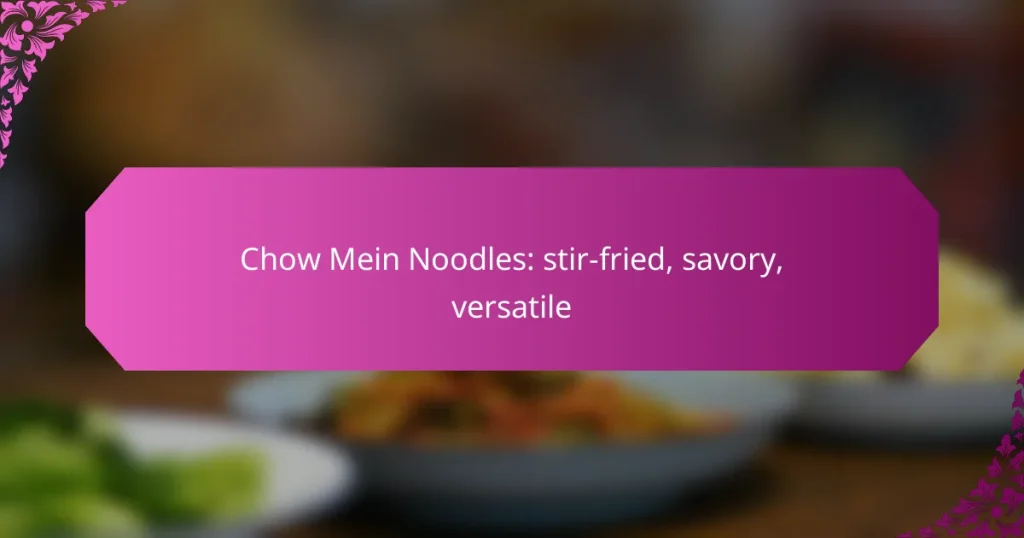Chinese cuisine offers a rich tapestry of flavors and textures, making it a must-try for food enthusiasts. In London, popular dishes like Peking Duck, Dim Sum, and Kung Pao Chicken showcase the diversity and authenticity of this culinary tradition. Exploring neighborhoods such as Chinatown and Soho will lead you to a variety of authentic dining experiences that celebrate these beloved dishes.
Sweet and Sour Pork: tangy, crispy, colorful
Chow Mein Noodles: stir-fried, savory, versatile
What are the most popular Chinese dishes in London?
In London, some of the most popular Chinese dishes include Peking Duck, Dim Sum, Kung Pao Chicken, Mapo Tofu, and Sweet and Sour Pork. These dishes are celebrated for their unique flavors and textures, making them favorites among locals and visitors alike.
Peking Duck
Peking Duck is a renowned dish known for its crispy skin and tender meat. Traditionally served with thin pancakes, hoisin sauce, and sliced vegetables, it offers a delightful combination of flavors and textures.
When ordering Peking Duck in London, look for restaurants that prepare it in-house, as the preparation can take several hours. A well-prepared Peking Duck can be a centerpiece for special occasions or gatherings.
Dim Sum
Dim Sum refers to a variety of small dishes served in steamer baskets or on small plates, perfect for sharing. Popular items include dumplings, buns, and rolls, often enjoyed with tea.
In London, many restaurants offer Dim Sum brunches, making it a social dining experience. Be sure to try a mix of steamed and fried options for a well-rounded taste.
Kung Pao Chicken
Kung Pao Chicken is a spicy stir-fry dish made with chicken, peanuts, and vegetables, flavored with soy sauce and chili peppers. This dish is known for its balance of heat and sweetness.
When ordering Kung Pao Chicken, consider asking for the spice level to suit your preference. It pairs well with steamed rice, which helps balance the flavors.
Mapo Tofu
Mapo Tofu is a popular Sichuan dish featuring soft tofu in a spicy sauce made from fermented broad bean paste and ground meat, usually pork or beef. The dish is known for its bold flavors and numbing spiciness.
In London, you can find variations of Mapo Tofu that cater to different spice tolerances. It’s a great option for those looking to explore authentic Sichuan cuisine.
Sweet and Sour Pork
Sweet and Sour Pork is a classic dish characterized by its vibrant sauce made from sugar, vinegar, and ketchup, coating tender pieces of pork. This dish is loved for its tangy and sweet flavor profile.
When trying Sweet and Sour Pork in London, look for places that use fresh ingredients for the best taste. It’s often served with rice or as part of a larger meal.
Where can I find authentic Chinese restaurants in London?
Authentic Chinese restaurants in London can be found in various neighborhoods known for their vibrant culinary scenes. Key areas include Chinatown, Soho, and East London, each offering a unique selection of traditional dishes and dining experiences.
Chinatown
Chinatown is the heart of Chinese cuisine in London, featuring numerous restaurants that serve a wide range of dishes from different regions of China. Here, you can find everything from dim sum to Peking duck, often in a lively and culturally rich atmosphere.
When visiting Chinatown, look for restaurants that are busy with locals, as this often indicates quality and authenticity. Popular spots include the iconic Four Seasons and the bustling Dumplings’ Legend.
Soho
Soho is another hotspot for authentic Chinese dining, offering a mix of traditional and modern interpretations of Chinese cuisine. This area is known for its trendy restaurants and fusion dishes that still honor classic flavors.
Consider trying places like BaoziInn for their unique steamed buns or Yauatcha for a contemporary dim sum experience. Reservations are recommended, especially during peak dining hours.
East London
East London has seen a rise in authentic Chinese eateries, particularly in areas like Hackney and Shoreditch. These neighborhoods feature a blend of traditional and innovative Chinese dishes, often with a focus on fresh, locally sourced ingredients.
Restaurants such as Dumpling Shack and The Good Life Eatery are popular choices, offering a casual dining experience with high-quality food. Exploring street food markets in this area can also lead to discovering hidden gems serving authentic Chinese flavors.
What are the key ingredients in traditional Chinese cuisine?
Traditional Chinese cuisine relies on a variety of key ingredients that create its distinctive flavors and textures. Staples such as rice, noodles, tofu, and a wide array of vegetables form the foundation of many dishes.
Rice
Rice is a fundamental component of Chinese meals, serving as a staple carbohydrate. It is typically steamed or boiled and can be served plain or flavored with ingredients like soy sauce or sesame oil.
In regions like southern China, rice is often the primary staple, while northern areas may favor wheat-based products. Jasmine and sticky rice are popular varieties that enhance different dishes.
Noodles
Noodles are another essential ingredient in Chinese cuisine, available in various forms such as wheat, rice, and egg noodles. They can be stir-fried, boiled, or served in soups, making them versatile for many recipes.
Popular dishes include chow mein and lo mein, which highlight the chewy texture of noodles. Fresh noodles are preferred for their flavor and texture, while dried noodles are convenient for quick meals.
Tofu
Tofu is a significant protein source in Chinese cooking, made from soybeans. It comes in various textures, from silken to firm, allowing it to be used in soups, stir-fries, or as a meat substitute.
When cooking with tofu, pressing it to remove excess moisture can enhance its ability to absorb flavors. Marinating tofu before cooking can also add depth to its taste.
Vegetables
Vegetables play a crucial role in traditional Chinese dishes, providing color, nutrition, and flavor. Common choices include bok choy, Chinese broccoli, and bell peppers, often stir-fried or steamed.
Seasonal and local produce is emphasized, with a focus on freshness. Incorporating a variety of vegetables not only enhances the dish’s visual appeal but also contributes to a balanced diet.
How do I choose the best Chinese dish for my taste?
To choose the best Chinese dish for your taste, consider your preferences for spice, protein, and dietary restrictions. Understanding these factors will help you navigate the diverse offerings in Chinese cuisine and find dishes that suit your palate.
Consider spice level
Spice level is a crucial factor in selecting a Chinese dish. Some regional cuisines, like Sichuan, are known for their bold and spicy flavors, while others, like Cantonese, tend to be milder. If you prefer less heat, look for dishes that feature steamed or stir-fried ingredients without heavy use of chili peppers.
When trying a new dish, ask about its spice level or request adjustments. Many restaurants can customize the heat to your liking, allowing you to enjoy the flavors without overwhelming your taste buds.
Think about protein preferences
Your protein preferences will significantly influence your choice of Chinese dishes. Common proteins include chicken, beef, pork, and seafood, each offering distinct flavors and textures. For instance, Kung Pao Chicken is a popular choice for chicken lovers, while Mapo Tofu caters to those who enjoy a spicy, tofu-based dish.
If you have dietary restrictions, such as avoiding red meat or shellfish, be sure to communicate this when ordering. Many restaurants offer a variety of protein options, allowing you to find a suitable dish that meets your needs.
Explore vegetarian options
Vegetarian options in Chinese cuisine are abundant and can be just as flavorful as meat-based dishes. Look for vegetable stir-fries, tofu dishes, or noodle soups that highlight fresh produce and savory sauces. Dishes like Buddha’s Delight or Vegetable Lo Mein are excellent choices for vegetarians.
When dining out, inquire about vegetarian specialties or ask for modifications to existing dishes. Many Chinese restaurants are accommodating and can prepare meals that align with vegetarian diets without sacrificing taste.
What are the regional variations of Chinese dishes?
Chinese cuisine features diverse regional variations, each with unique flavors, ingredients, and cooking techniques. Key regions include Cantonese, Sichuan, and Shandong, each offering distinct culinary experiences that reflect local culture and preferences.
Cantonese Cuisine
Cantonese cuisine is known for its emphasis on fresh ingredients and subtle flavors. Dishes often highlight the natural taste of the ingredients, using techniques such as steaming and stir-frying. Popular dishes include dim sum, roast duck, and sweet and sour pork.
When exploring Cantonese food, consider trying a variety of dim sum, which includes small plates of dumplings, buns, and other snacks. This style encourages sharing and sampling multiple dishes, making it a social dining experience.
Sichuan Cuisine
Sichuan cuisine is famous for its bold flavors and spicy dishes, characterized by the use of Sichuan peppercorns and chili peppers. The cuisine balances heat with complex flavors, often incorporating garlic, ginger, and fermented ingredients.
Signature dishes include mapo tofu and kung pao chicken. If you enjoy spicy food, Sichuan cuisine offers a thrilling experience, but be cautious with the heat level, as it can be intense for those unaccustomed to it.
Shandong Cuisine
Shandong cuisine is one of the oldest styles of Chinese cooking, known for its emphasis on seafood and hearty flavors. It often features techniques like braising and frying, with a focus on preserving the natural taste of ingredients.
Common dishes include sweet and sour carp and various soups. When trying Shandong cuisine, pay attention to the use of vinegar, which adds a distinctive tang to many dishes, enhancing the overall flavor profile.


